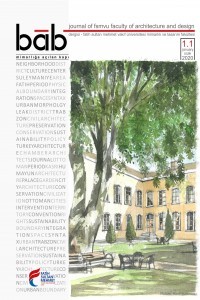Orta ve Uzak Doğu Mimari Kültüründe Katmanlı Ahşap Kiriş Yapı Sisteminin Mekan ve Form Yapımındaki Rolü
Katmanlı kiriş, çeşitli kültürlerde, özellikle ahşap çerçeve yapısını kullananlarda bilinen bir sistemdir. Java, Endonezya'da 'tumpang sari', Türkiye'de 'bindirmeli kiriş' ve Çin'de 'dougong' olarak bilinir. Katmanlı bir ahşap kiriş, temel olarak, bir kompozit kiriş sistemi olarak çalışan iki veya daha fazla ahşap kütük yığınından oluşur. Bu istifleme konfigürasyonu yukarı doğru veya dikey olarak düz olarak genişletilebilir. Bu katmanlama sistemi, daha uzun ve yüzer bir çatı veya saçak oluşumuna izin verirken, ahşap çerçevenin sertliğini artırmayı amaçlamaktadır. Katmanlı ahşap kiriş, mimaride mekan oluşturma ve form oluşturmada rol oynar. Güneydoğu Asya, Doğu Asya ve Anadolu Türkiye mimarisinde, katmanlı ahşap kiriş sistemi, piramit, kubbe veya tonoz benzeri bir iç mekanla sonuçlanan ters bir piramit şekli oluşturarak yukarı doğru genişleme eğilimindedir. İç veya dış mekanlara yerleştirilebilir, farklı yüksekliklerde tam veya yarım konfigürasyonda kullanılabilir. Bu makale, Endonezya, Türkiye ve Çin gibi Orta ve Uzak Doğu kültürlerinde katmanlı ahşap kiriş sisteminin kullanımını keşfetmenin yanı sıra mekan oluşturma ve form oluşturmadaki rolünü araştırmayı amaçlamaktadır. Literatür çalışmaları ile benzer bir yapım sisteminin farklı mimarilerde mekanın şekillenmesine nasıl yardımcı olduğuna dair betimsel bir sonuç çıkması beklenmektedir. Bu makale ayrıca, katmanlı ahşap kirişlerin uygulanmasıyla üretilen alanı biçimsel estetik ve sembolik bakış açısından tartışmaktadır.
Anahtar Kelimeler:
Katmanlı kiriş, geleneksel mimari, Ahşap kiriş, Ahşap, Ahşap yapı
The Role of Layered Wooden Beam Constructional System in Space Making and Form Making in The Middle and Far-Eastern Architectural Culture
A layered beam is a system that is known in various cultures, especially those that utilize a wooden frame structure. It is known as ‘tumpang sari’ in Java, Indonesia, ‘bindirmeli kiriş’ in Turkey, and ‘dougong’ in China. A layered wooden beam basically consists of two or more stacks of wood logs that work as a composite beam system. This stacking configuration can be widened upwards or vertically straight. This layering system is intended to increase the stiffness of the wooden frame while allowing the formation of a longer and floating roof or eaves. Layered wooden beam plays a role in space-making and form-making in architecture. In the architecture of South-East Asia, East Asia, and Anatolian Turkey, the layered wooden beam system tends to widen upward forming an inverted pyramid shape resulting in a pyramid, dome, or vault-like interior space. It can be placed in the interior or exterior, used in full or half configuration with varying heights. This paper aims to explore the use of the layered wooden beam system in the Middle and Far-Eastern cultures such as Indonesia, Turkey, and China, as well as to investigate its role in space-making and form-making. With literature studies, it is expected that a descriptive result about how a similar construction system helped shape the space on various architectures. This paper also discusses the space produced by the application of layered wooden beams from the formal aesthetics and symbolic point of view.
Keywords:
Layered beam, traditional architecture, wooden beam wood construction, Katmanlı kiriş, geleneksel mimari, Ahşap kiriş, Ahşap,
___
- ALAMI, M. H., 2001. Al-bayan wa l-bunyan: meaning, poetics, and politics in early Islamic architecture. Berkeley: University of California.
- CHING, F. D., 2007. Architecture: form, space, and order. New Jersey: John Wiley & Sons.
- FRICK, H., 1997. Pola struktural dan teknik bangunan di Indonesia. Yogyakarta: Kanisius.
- LIU, D. Z., 1982. Anthology of dunzhen liu. PRC: China Construction Industry Press.
- MA, B. J., 2003. Chinese ancient architecture woodwork construction technology. PRC: Science Press.
- Yayın Aralığı: Yılda 2 Sayı
- Başlangıç: 2020
- Yayıncı: Fatih Sultan Mehmet Vakıf Üniversitesi
